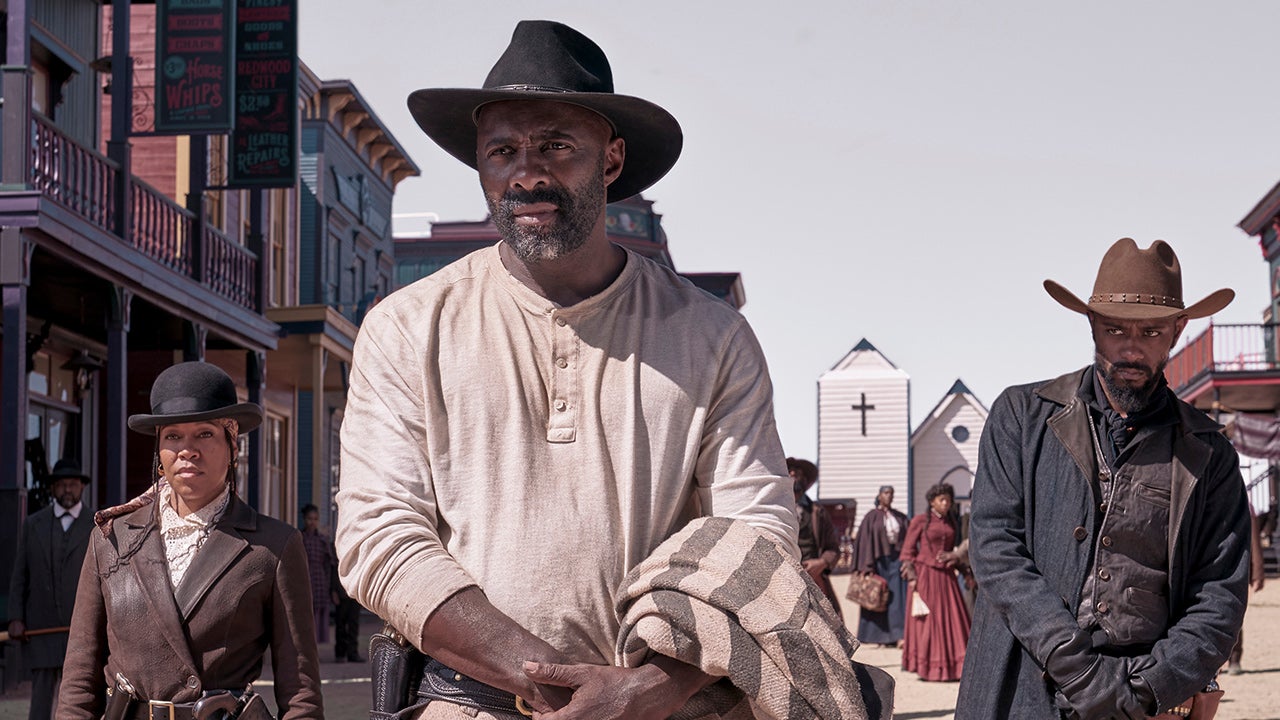Few films announce their mission statement within their opening frames to quite the extent of The Harder They Fall. An introductory title card informs the audience that while this film is fictional, “these people lived”––a reference not just to the many real historical figures who populate director Jeymes Samuel’s feature directorial debut, but also the many blindspots of the Western. The genre as a whole is largely built upon whitewashed depictions of an America that never was, so much so that whenever a Black protagonist appears in a contemporary version the word “revisionist” is often not far behind, incorrectly used as a lazy shorthand. It now feels like common knowledge that a richer history of Black cowboys has largely been overlooked in screen depictions of the era. The revisionist descriptor as it pertains to historical accuracy may now feel more apt when describing a classic John Wayne vehicle than a film that has a better handle on the broad strokes of fact, despite an introduction touting its fictionality.
Thus it could be argued there’s something refreshing about how The Harder They Fall feels like a greatest-hits package of Western tropes, conforming to genre expectations rather than subverting them––breaking new ground by simply aiming to beat the countless white filmmakers who came before at their own game. And for a significant portion of the runtime, this refreshing corrective to Hollywood whitewashing does enough to sustain interest, the impressive ensemble helping to elevate the director’s liberal utilization of stylistic tics (from Leone and Peckinpah) beyond mere genre pastiche. The problem is that Samuel’s film does little beyond this, settling too comfortably into western conventions that it becomes more defined by its correspondence with films that came before it than existing as a singular work in its own right.
As a child, Nat Love (Jonathan Majors) witnessed his parents get murdered at the family dinner table by Rufus Buck (Idris Elba), a crucifix branded into his forehead the waking reminder of the tragedy. Many years later he’s in the midst of putting a gang together in pursuit of revenge. With Rufus newly freed from incarceration by his gang, led by Trudy Smith (Regina King) and Cherokee Bill (LaKeith Stanfield), the tables are set for a bloody climactic showdown, Nat aiming to finally get closure for the childhood events that shaped the man he became.
Western storylines seldom come simpler than this, and Samuel knows it. His opening credits introduces the ensemble in accordance with their characters’ gang allegiances, letting the viewer know which side everybody is on before they’ve even had a chance to wander onscreen. It’s a decision made so as to not distract from the surface=level genre pleasures that follow, from hyper-violent train and bank robberies to the deliberately artificial sets that are straight out of Spahn Ranch. Throughout the first act this proves infectious, the director following Tarantino’s “film as mixtape” philosophy for paying homage to some of the genre’s most distinctive auteurs. Shootouts are defined by extreme closeups straight out of The Good, the Bad and the Ugly, and the excess blood splatter recalls Sam Peckinpah’s approach to staging violence in The Wild Bunch.
The goodwill towards the film in its early stages is aided considerably by its ensemble, though the most commanding presences are by far on Rufus Buck’s side. Idris Elba has long been underserved on the big screen, taking villainous roles in tentpole blockbusters where it can often feel like he’s coasting by on pure charisma. It’s telling that Rufus Buck is comparatively sparse as a character, his introductory scenes (both in flashback and present day) establishing him as a force to be reckoned with via expression alone. Most striking is a moment of tenderness amidst the bloodshed: a handcuffed Rufus calmly putting his head on the shoulders of Bill and Trudy as they free him from incarceration, a tiny detail illuminating a bond deeper than mere gang allegiances. There’s nothing on the other side of the storyline that feels anywhere near as powerful; Jonathan Majors’ turn as Nat Love feels comparatively flat when placed in opposition to three performers who could do this in their sleep, and by the third act often feel like they are.
The highly specific emotional dynamics are eventually flattened in order to streamline the simplistic inter-gang rivalries, and anything of greater intrigue is left firmly in the margins. Historical details of interest, such as the racism Black cowboys acted in response to, are treated as either footnotes or sight gags, while Samuel’s own background in music increasingly becomes a crutch. Working alongside regular collaborator Jay-Z, the pair have collated a soundtrack that eventually defines the film more than its western influences, seemingly every other scene punctuated by a modern needle drop; that the pair previously collaborated on the soundtrack for Baz Luhrmann’s The Great Gatsby should tell you all you need to know.
It’s far from the first movie to use this technique, with everything from Tarantino using Rick Ross in Django Unchained to Will Smith rapping over a Stevie Wonder sample in Wild Wild West spotlighting the surprising chemistry between modern Westerns and contemporary Black artists across a variety of musical genres. But The Harder They Fall acts like this is part of its convention-busting status, rather than a now accepted facet of the genre, a trope struggling to convince it’s breathing new life.
Instead of breaking new ground, The Harder They Fall often feels reluctant to innovate—a love letter to classic westerns that initially succeeds at homage, only to find itself succumbing to cliche.
The Harder They Fall premiered at the BFI London Film Festival and will open in theaters on October 22 and on Netflix on November 3.

